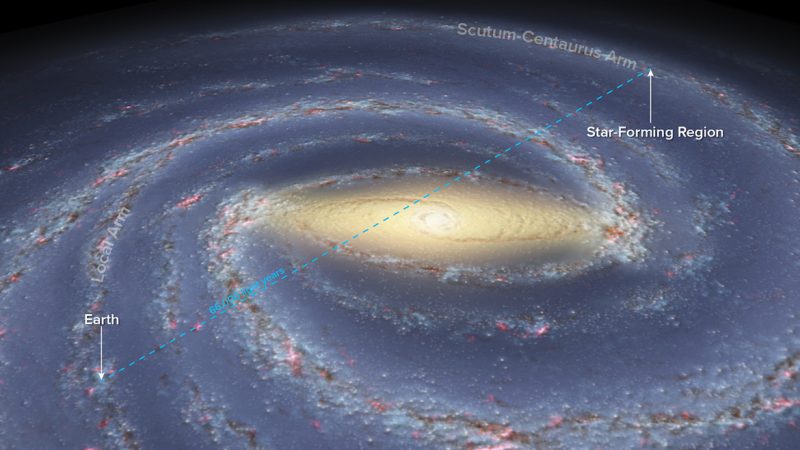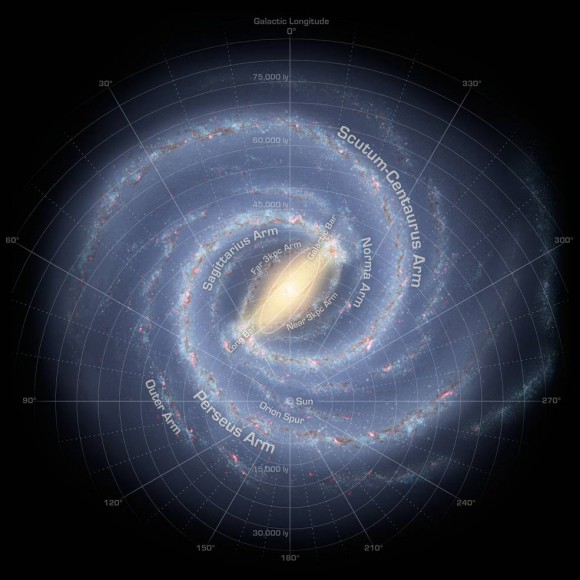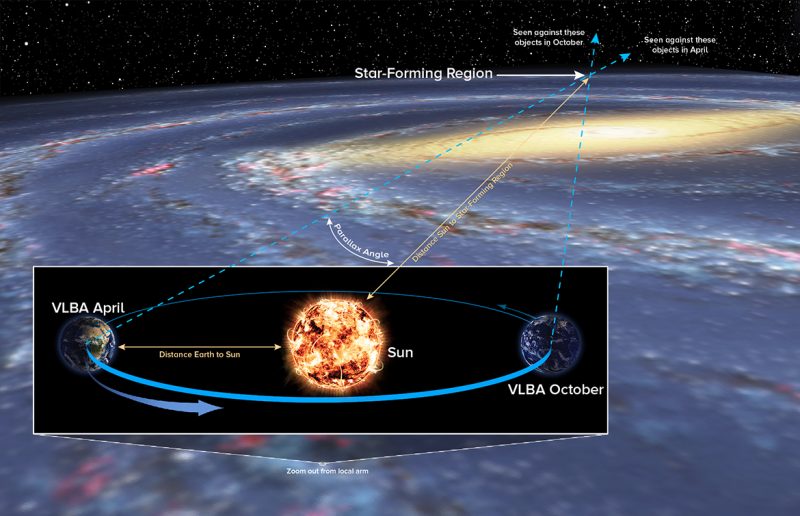
We can look billions of light-years away in space, and estimate the distances to faraway galaxies via their redshifts, but direct measurements are harder. Astronomers are getting better at direct measurements, though, and today (October 12, 2017) they announced they’ve used the Very Long Baseline Array (VLBA) to obtain a direct measurement to a star-forming region on the opposite side of our Milky Way. It’s impressive, and these astronomers said their achievement nearly doubles the previous record for distance measurement within the galaxy. Alberto Sanna, of the Max-Planck Institute for Radio Astronomy (MPIfR) in Germany said in a statement:
This means that, using the VLBA, we now can accurately map the whole extent of our galaxy.
These astronomers measured a distance of more than 66,000 light-years to a star-forming region called G007.47+00.05 on the opposite side of the Milky Way from our sun. The region is well past the galaxy’s center, which is some 27,000 light-years distant. The previous record for a parallax measurement was about 36,000 light-years. Sanna said:
Most of the stars and gas in our galaxy are within this newly-measured distance from the sun. With the VLBA, we now have the capability to measure enough distances to accurately trace the galaxy’s spiral arms and learn their true shapes.
And that’s exciting! It’s a little like being able to look at ourselves in a mirror for the first time.

The astronomers statement explained:
Distance measurements are crucial for understanding the structure of the Milky Way. Most of our galaxy’s material, consisting principally of stars, gas, and dust, lies within a flattened disk, in which our solar system is embedded. Because we can’t see our galaxy face-on, its structure, including the shape of its spiral arms, can only be mapped by measuring distances to objects elsewhere in the galaxy.
The astronomers used a time-honored distance-finding technique – trigonometric parallax – first used in 1838 to measure the distance to a star. If you want to understand parallax, hold one finger in front of your nose, and shut first one eye, then the other. You’ll see your finger appear to shift with respect to background objects. In the same way, astronomers can see a shift in the positions of stars from one side of the Earth’s orbit to another. Then they can use trigonometry to calculate the stars’ distances. This technique enabled astronomers in the 1800s to begin to measure the distances to nearby stars. Hence, parallax was one of the first tools used by astronomers that ultimately resulted in our modern picture of the universe.
With parallax, though, at first, only the nearest stars’ distances could be measured. That’s because, the greater the distance, the smaller the observed shift. Over time, with advancing technologies, astronomers have been able to use parallax to directly measure greater and greater distances. For the measurement across the width of the Milky Way, they used the continent-wide VLBA. This radio telescope system consists of 10 dish antennas distributed across North America, Hawaii, and the Caribbean.
It has the ability to measure the minuscule angles associated with great distances. In this case, said these astronomers:
… the measurement was roughly equal to the angular size of a baseball on the moon.
The VLBA observations measured the distance to a region where new stars are being formed. Such regions include areas where molecules of water and methanol act as natural amplifiers of radio signals — masers, the radio-wave equivalent of lasers for light waves. This effect makes the radio signals bright and readily observable with radio telescopes. Karl Menten at MPIfR commented:
The Milky Way has hundreds of such star-forming regions that include masers, so we have plenty of ‘mileposts’ to use for our mapping project, but this one is special. We’re looking all the way through the Milky Way, past its center, way out into the other side.
The astronomers said their goal is to reveal what our own galaxy looks like if we could leave it, travel outward perhaps a million light-years, and view it face-on, rather than along the plane of its disk. This task will require many more observations and much painstaking work, but, the scientists say, the tools for the job now are in hand. Mark Reid of the Harvard-Smithsonian Center for Astrophysics (CFA) predicted:
Within the next 10 years, we should have a fairly complete picture.

Bottom line: Astronomers used parallax to obtain a direct measurement past the center of our galaxy, to the Milky Way’s far side.
Source: “Mapping Spiral Structure on the Far Side of the Milky Way,” Alberto Sanna, Mark J. Reid, Thomas M. Dame, Karl M. Menten & Andreas Brunthaler, 2017 Oct. 13, Science.











